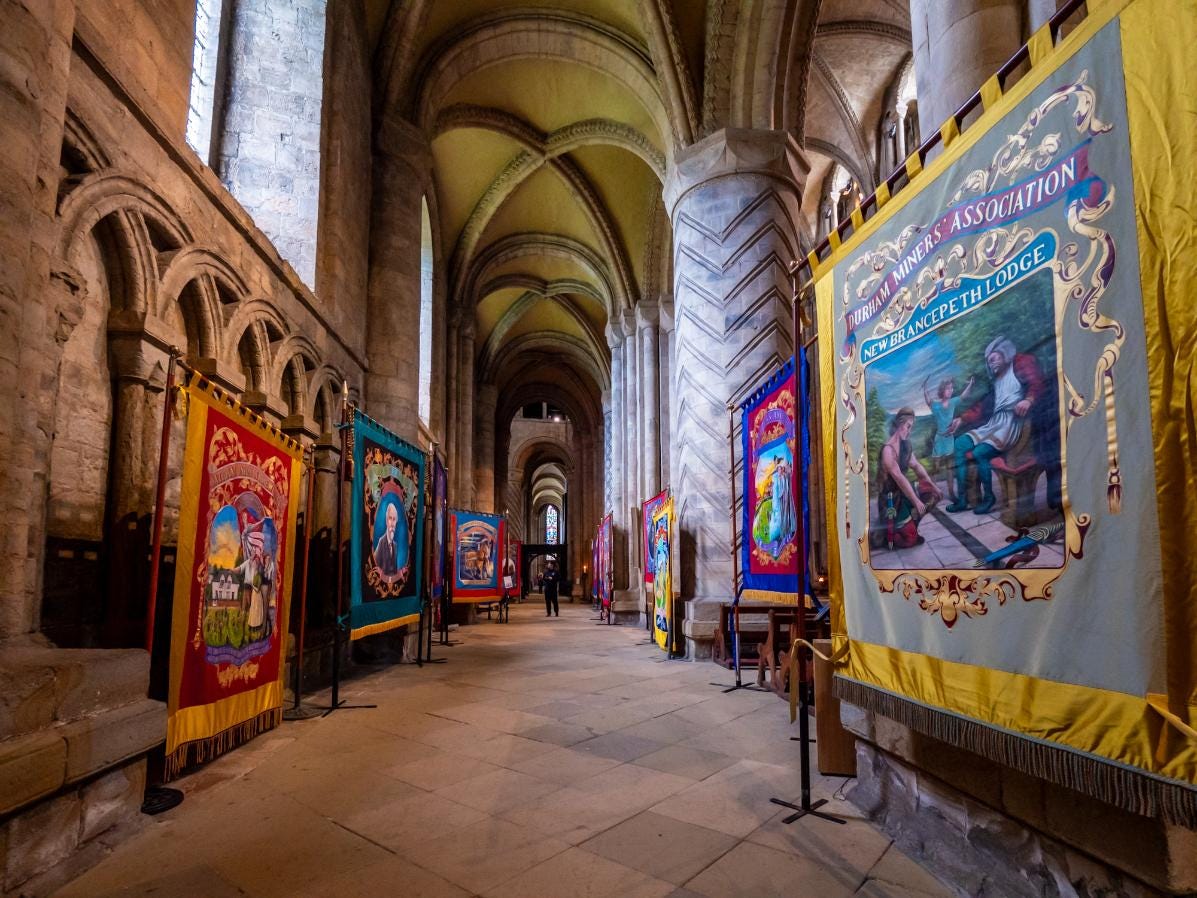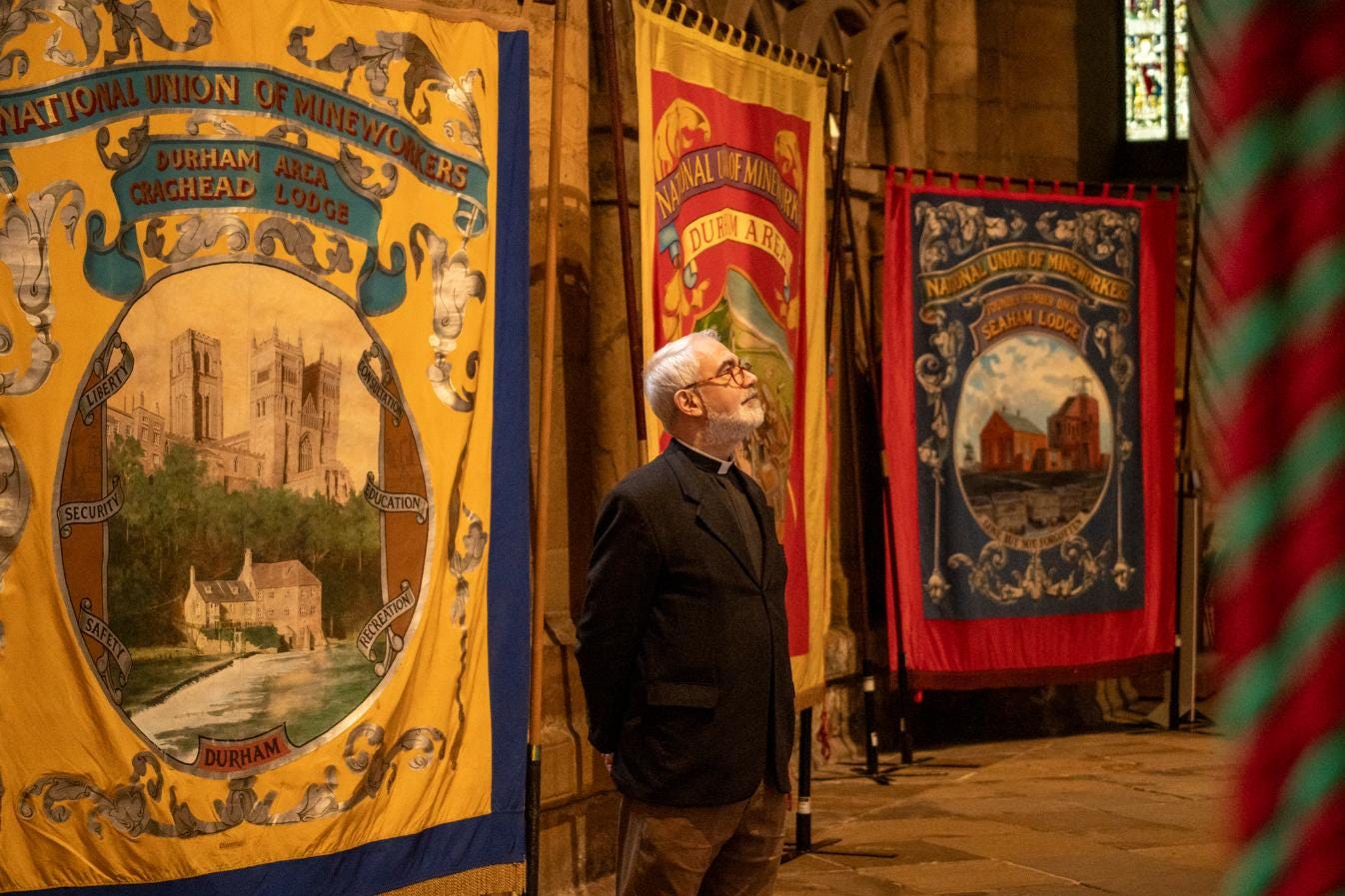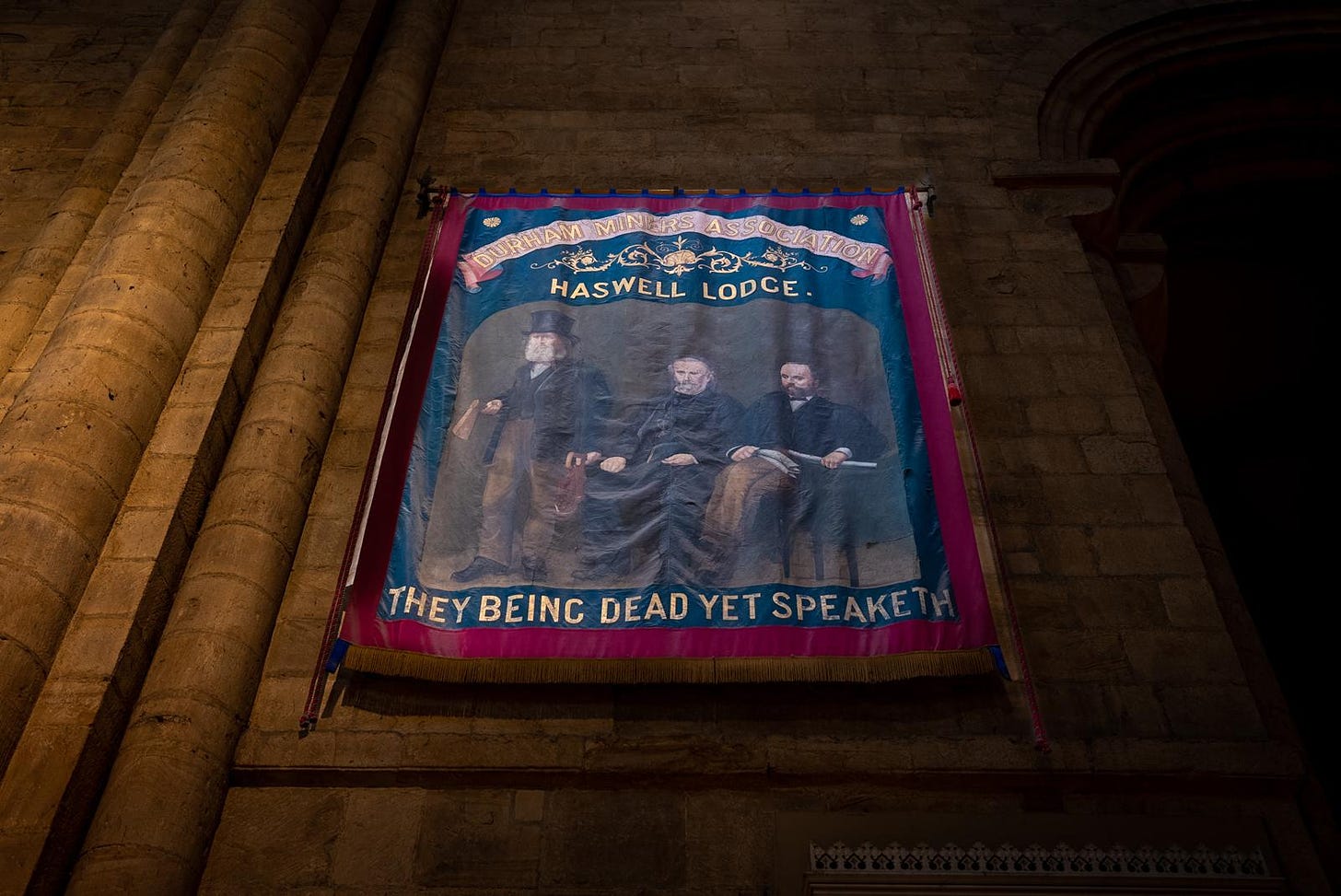
The long-standing link between the cathedral and the surrounding former mining communities was further reinforced by a new exhibition of 40 mine banners.
Solidarity Forever: Flags of the Durham Mining Community at Durham Cathedral marks the 40thth anniversary of the bitter miners’ strike.
The display includes original, restored and replica banners. Most display the name of their mine and union branch or “lodge,” along with religious or political imagery and mottoes.
The exhibition, which runs until November 7, is supported by Durham Mining Communities Banner Groups Association, Women’s Banner Group and Durham Miners’ Association.
Although the Durham Coalfield no longer exists, the Durham Miners’ Gala every July continues to thrive when the flags fly. Since 1896, a miners’ holiday service has been held in the cathedral on the afternoon of the feast day. During the service, new union lodge flags were consecrated and blessed by the Bishop of Durham

The first Durham Miners’ Gala, or “Big Meeting”, was held in 1871. It began as a demonstration of miners’ solidarity, showing employers that they were united and would stand up for their rights. The gala has become the largest informal gathering of miners and trade unions in the UK.
Cathedral archaeologist Norman Emery, who is secretary of the banner group in his home former village of Ash Winning, said: “These banners are the heritage of communities and reflect the struggles of the past for political reform, improvements in social conditions and the desire to move forward.
“There has always been a close relationship between the cathedral and the communities.”
The Rt Revd Canon Michael Hampel, Deputy Dean and Warden of Durham Cathedral, said: “The highlight of the year is the Great Meeting. He carries the flags to the cathedral.
“When there was talk of an exhibition of banners to mark the 40thth anniversary of the miners’ strike, Durham Cathedral seemed the obvious venue and we were delighted to be able to say a big yes to these magnificent emblems of North East communities.

“I remember speaking to the Durham Miners’ Association recently and asking ‘what does it mean to you to come to the cathedral every July’ and they said something very beautiful: ‘when we walk into the cathedral we know we still matter’.
“I think that’s a very strong comment. The mining community is very important.”
The cathedral’s links with coal go back a long way. Coal was a valuable source of income for the medieval monastery of Durham, and between 1100 and 1500 the monks mined coal at around 40 sites in County Durham.
After the Reformation many of the Priory’s lands were transferred to the new Dean and Chapter of Durham Cathedral and continued to provide a steady income. By 1830 a quarter of the cathedral’s total income came from coal.
Andrew Usher, Chief Visitor Experience and Enterprise Officer said: “We are honored to host Miner’s Flags. Durham Cathedral and the local mining communities have strong links dating back to the 1800s and this exhibition not only tells the story of the region’s mining heritage, but is a celebration of the fantastic local banners representing each mine and the community spirit that continues in the region. “

Patricia Simmons, from Durham Mining Communities Banner Groups Association, said: “We encourage former mining communities and the younger generation to recognize the importance these vibrant and colorful banners have in Durham’s history and the stories they tell.
“The group’s aim is to restore the many original banners or replace them with new ones to celebrate the lives of miners, both past and present, who despite overcoming many hardships shaped the communities we have today.”
“Across the country, the Durham Miners’ Gala is one of the best displays of these beautiful, story-telling banners that are part of our heritage. Being able to stage this exhibition in the historic grandeur of Durham Cathedral demonstrates how committed we are to continuing to celebrate the past, but looking to the future.”
The flag of Haswell Colliery is permanently displayed in the cathedral. The colliery was the scene of an explosion that killed 95 men and boys in 1844. The flag dates from 1893 and was placed in the cathedral in 1989.

In the South Nave Aisle is the Miners’ Memorial, dedicated in 1947 to “…the miners of Durham who gave their lives in the pits of this county, and those who toil in darkness and danger in those pits today.”
Next to it is a Book of Memory with a hanging lamp above it. It lists the many men and boys who lost their lives in accidents while working in the Durham quarry.
Five Bishops of Durham in particular hold a special place in the memories of miners in the region:
Brooke Fosse Westcott (1890 – 1901)
Negotiated between miners and employers during the strike of 1892. Helped found the Durham Aged Miners’ Home Association.
Handley Mole (1901 – 20)
I visited the pithead and the bereaved families after the West Stanley Colliery disaster in 1909 where 168 men and boys died. Wrote a miner’s anthem Oh Christ, your eyes of light and love.
Alvin Williams (1939 – 52)
Dedicated to the Miners’ Memorial in the Cathedral in 1947. Visiting the mine following the Easington Colliery disaster in 1951.
Ian Ramsay (1966 – 72)
Showed strong concern for mining communities. One of the guest speakers at the Gala in 1971, where he praised the Durham miners and their union as a “shining example” to other industries.
David Jenkins (1984 – 94)
He spoke out during the miners’ strike of 1984-85, saying that the miners “must not be defeated”. Criticized the government’s indifference to “poverty and powerlessness”.
The exhibition reflects the strike and the government’s initial plans to close 20 mines that were a threat to communities that depended on coal for work and were offered no alternative.
“It was a right-to-work strike, a brutal year-long struggle, but despite the protests, the closures continued, soon to be followed by many more.”

The last coal mill in the Durham Coalfield, Wearmouth, closed in 1994. This marked the end of an era for the region, which once had 304 mines employing 165,000 people.
Reverend Hampel said: “The mines are gone but the people survived and so did their flags. As we witness our mining heritage, we remember past hurts and pray for healing.”
The exhibition continues until November 7. For more information visit Durham Cathedral website.
